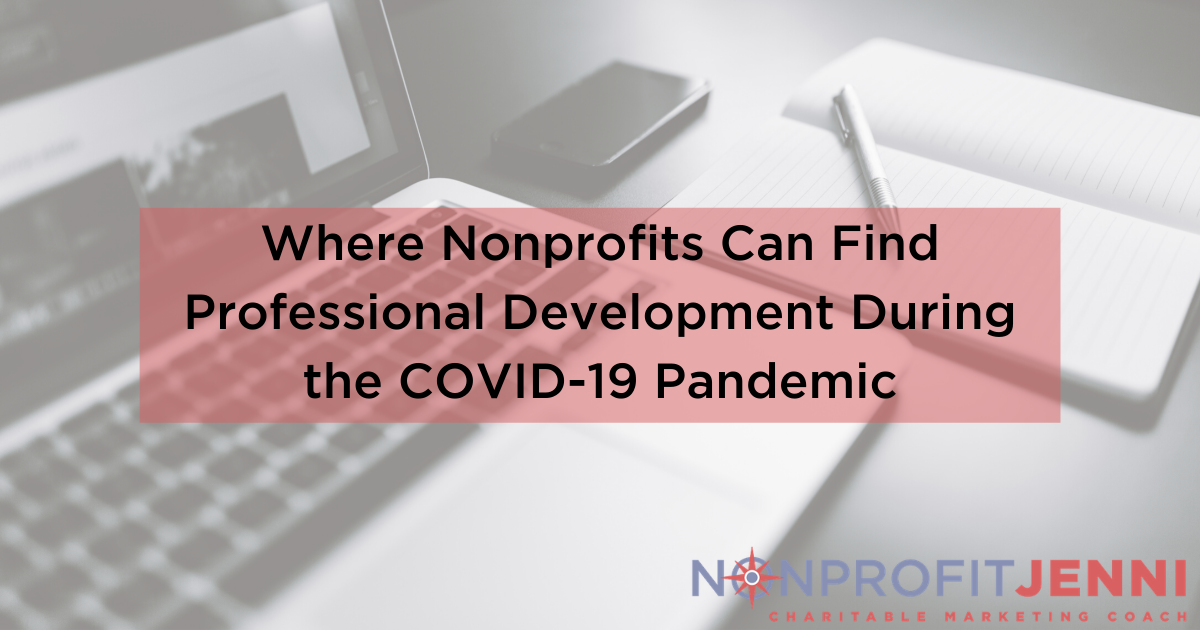As part of our ongoing series about how nonprofits can thrive in the face of COVID-19, we wanted to address questions we’ve received from leaders about how to fill staff and volunteer time. Many Executive Directors have told us they would like to use this time during “Safer at Home” periods to offer virtual professional development opportunities to staff and volunteers who aren’t able to carry out their normal roles. In this week’s episode of the Nonprofit Jenni Show, Jenni highlights a few high-quality professional development activities which can all be completed online.
#1 Nonprofit Strategic Planning Course
My good friend Holly Rustick, the podcast host of Grant Writing and Funding, has an amazing course to walk your nonprofit’s leaders through the strategic planning process. The course includes ten modules that walk your leadership team through the step-by-step process you can take to write your strategic plan.
What is a Strategic Plan, and Which Nonprofits Need One?
Strategic plans help your nonprofit grow by prioritizing your short-term and long-term goals and setting an action plan to help you reach those goals. Every nonprofit should always have a strategic plan, and your strategic plan should be revisited at least annually.
Holly also explains that nonprofit leaders should revisit their strategic plan when something unexpected comes up (such as the COVID-19 pandemic) and requires the nonprofit to make a major shift.
What is Included in a Strategic Plan?
Strategic plans are unique to each nonprofit and should be somewhat elastic so you can meet the changing needs of your community. That said, there are some basic components which should be included in every strategic plan. Some of these elements include:
Team Reflections: Who makes up your leadership and staff teams? What do they bring to the table, and what do they want to get out of their experience with your nonprofit?
SWOT Analysis: What strengths, weaknesses, opportunities, and threats impact your nonprofit? (Listen to the full episode for an example SWOT Analysis!)
Mission/Vision Statement: Are your mission and vision statements still accurate? Does everyone on your team know them by heart? Do these statements need to be reworked?
Target Demographic: Who or what cause do you serve?
Strengths and Needs Assessment: Are you still meeting the needs of your demographic? Are others in the community meeting or helping to meet those needs? Could others help you meet your demographic’s needs?
Resource Mapping: What resources are you working with, including money, human resources, partnerships, in-kind donations, volunteers, and others? How do you track these resources?
Contingency Planning: What challenges could come up in the future? How would you address these quickly?
Quarterly and Annual Calendars: What action steps do you need to take to achieve your goals?
If this seems overwhelming, check out Holly’s step-by-step strategic planning course for practical exercises you can use to create a strategic plan. My podcast listeners can even get a 50% discount on the course between now and May 14 when you visit grantwritingandfunding.com/jenni.
#2: Nonprofit SEO (Website Building) Mini-Course
The next professional development resource I recommend for your nonprofit during the coronavirus pandemic is my Nonprofit SEO Mini-Course.
This mini-course includes:
Definitions and examples of key SEO concepts
Tips for organizing your website
A checklist of everything you need on your website to make it “SEO-friendly”
What Does SEO Mean?
SEO is an acronym for Search Engine Optimization. When a nonprofit’s website is “optimized” for search engines, their website will show up on the first page of Google search results when people search for places to support the causes they care about most.
Here are some examples of search phrases people might type into Google in hopes of finding organizations like yours:
Local food banks/pet shelters/health clinics/whatever type of nonprofit you are
Online volunteer opportunities
Virtual events coming up this weekend
When people search for these types of phrases, it’s important to make sure you’re putting your best foot forward with search engine-optimized website practices so they can find your nonprofit!
#3: Silent Auction Guide
I also offer a Silent Auction Guide on my website, which has become extremely popular as nonprofits have started to try out online auctions as a virtual fundraising tactic.
This guide includes:
Tips for delegating auction tasks to avoid overwhelming staff
A checklist of what you need on hand when requesting item donations
Best practices for maximizing your auction revenue
Bonus Gift: Get my list of 140+ corporations which are known for generously donating their products to silent auctions! This list even includes notes on how each corporation prefers to receive donation requests.
#4: One-on-One Coaching Support
Finally, I wanted to remind you that I offer remote coaching support for nonprofit leaders who need help with:
Identifying practical action steps to reach short- and long-term marketing or fundraising goals
Brainstorming marketing or fundraising goals which align with the organization’s mission
Talking out specific, unexpected marketing or fundraising challenges that have arisen
When you sign up for coaching with me, you can expect:
Biweekly calls via Zoom or phone calls, each 50 minutes long
Wrap-up emails following each call summarizing the action items we identified for your organization
Encouragement and support when unexpected challenges arise
Also, I want to thank Adams Keegan for sponsoring this episode! Adams Keegan offers affordable employer solutions, and they have a special division which is solely dedicated to serving nonprofit organizations. Schedule a consultation call with them to get customized, free advice for your nonprofit’s HR policies and management.

